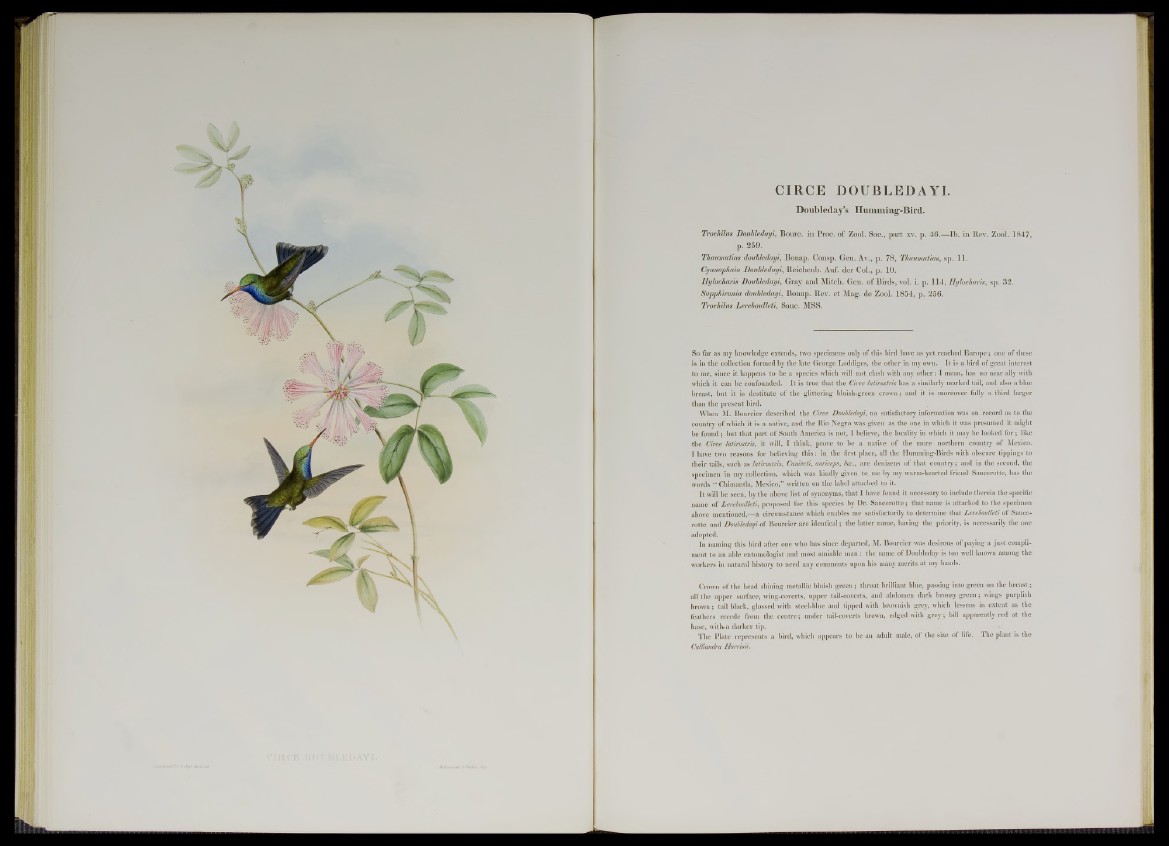
CIRCE DOUBLEDAYI.
Doubleday’s Humming-Bird.
Trochilus Douhledayi, Bourc. in Proc. o f Zool. Soc., p a rt xv. p. 4 6 .— lb . in Rev. Zool. 1847,
p. 259.
TTiaumatias douhledayi, Bonap. Consp. Gen. Av., p. 78, Thaumatias, sp. 11.
Cyanophaia Douhledayi, Reichenb. Auf. der Col., p. 10.
Hylochari8 Douhledayi, Gray and Mitcb. Gen. o f Birds, vol. i. p. 114, Hylocharis, sp. 32.
Sapphironia douhledayi, Bonap. Rev. e t Mag. de Zool. 1854, p. 256.
Trochilus Lereboulleti, Sauc. MSS.
So far as my knowledge extends, two specimens only of this bird have as yet reached Europe; one of these
is in the collection formed by the late George Loddiges, the other in my own. It is a bird of great interest
to me, since it happens to be a species which will not clash with any other: I mean, has no near ally with
which it can be confounded. It is true that the Circe latirostris has a similarly marked tail, and also a blue
breast, but it is destitute of the glittering bluish-green crown; and it is moreover fully a third larger
than the present bird.
When M. Bourcier described the Circe Douhledayi, no satisfactory information was on record as to the
country of which it is a native, and the Rio Negro was given as the one in which it was presumed it might
be found; but that part of South America is not, I believe, the locality in which it may be looked fo r; like
the Circe latirostris, it will, I think, prove to be a native of the more northern country of Mexico.
I have two reasons for believing this: in the first place, all the Humming-Birds with obscure tippings to
their tails, such as latirostris, Caniveti, auriceps, &c., are denizens of that country; and in the second, the
specimen in my collection, which was kindly given to. me by my warm-hearted friend Saucerotte, has the
words “ Chimantla, Mexico,” written on the label attached to it.
It will be seen, by the above list of synonyms, that I have found it necessary to include therein the specific
name of Lereboulleti, proposed for this species by Dr. Saucerotte; that name is attached to the specimen
above mentioned,—a circumstance which enables me satisfactorily to determine that Lereboulleti of Saucerotte
and Douhledayi of Bourcier are identical; the latter name, having the priority, is necessarily the one
adopted.
In naming this bird after one who has since departed, M. Bourcier was desirous of paying a just compliment
to an able entomologist and most amiable man : the name of Doubleday is too well known among the
workers in natural history to need any comments upon his many merits at my hands.
Crown of the head shining metallic bluish green; throat brilliant blue, passing into green on the breast;
all the upper surface, wing-coverts, upper tail-coverts, and abdomen dark bronzy green; wings purplish
brown; tail black, glossed with steel-blue and tipped with brownish grey, which lessens in extent as the
feathers recede from the centre; under tail-coverts brown, edged with grey; bill apparently red at the
base, with» a darker tip.
The Plate represents a bird, which appears to be an adult male, of the size of life. The plant is the
Calliandra Harrisii.